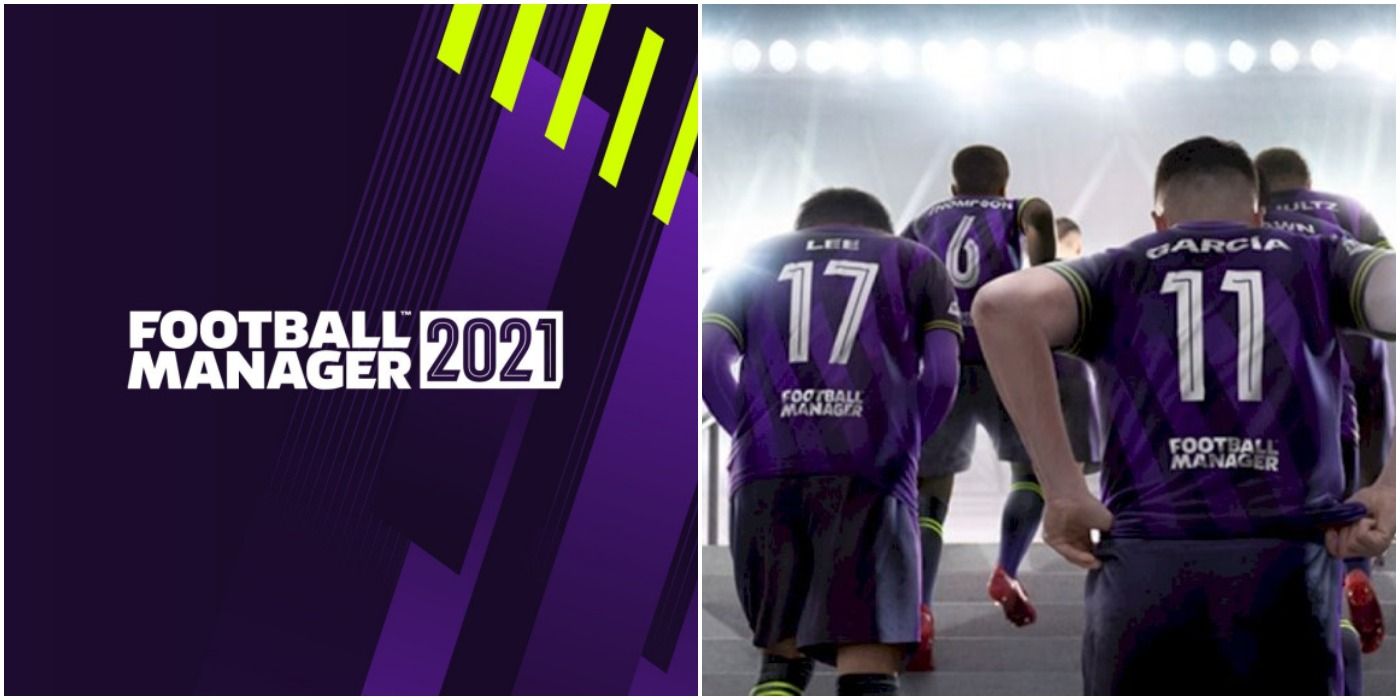
dSports Interactive, who initially made their name with the Championship Manager series, have become a dominant force in management sim genre with their Football Manager franchise. Electronic Arts and Codemasters have tried to challenge Football Manager for the throne with their FIFA Manager and LMA Manager series' respectively, but both have since ceased to exist following the continued success of Sports Interactive's game.
RELATED: The 10 Best Sports Games Of 2020, Ranked (According To Metacritic)
One of Football Manager's key selling points is the incredible level of detail and customizability that has been built over the course of numerous yearly iterations. Unfortunately, the amount of customizability can make the game extremely overbearing for people that are new to the game, making them susceptible to heavy defeats due to not understanding how to set up their team. This guide aims to help such people, as well as those simply looking for something solid and reliable to use, by offering four different shapes and two tactical approaches that have been tried and tested in the sport for many years.
It's worth making clear that the tactics presented should be used as a general guideline, rather than something that should be copied; the reason being is that every player has, of course, different strengths and weaknesses, so things like player roles and individual instructions need to be adapted to their specific needs. It's also important to note that the Mentality will be set to Cautious in all shapes, as this is a reliable option when playing a defensive style, but it should be changed depending on the strength of the opposition.
Updated April 30, 2021, by Jack Pursey: One of the best things about Football Manager is that there are no right or wrong ways to approach a game, and the potential changes and tweaks that can be made to a team's tactical approach are endless. All that matters at the end of the day is achieving positive results, with the way in which it's achieved being somewhat of a moot point. Therefore, we have decided to update this list to add a slight variation under each entry, to give a few more ideas for how to set teams up in a solid, defensive way.
10 Shape #1 - 4-4-2
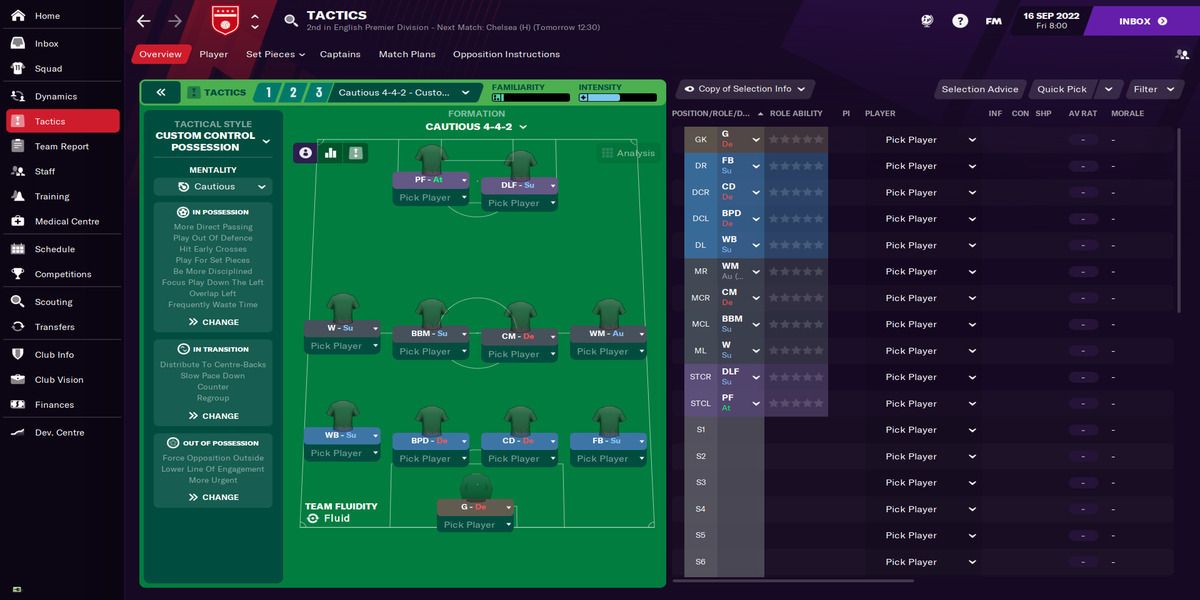
For many years, the 4-4-2 formation was mocked for being outdated. It was criticized for being too attacking due to having two strikers, as well as being susceptible to midfield overloads, as many teams now play with three central midfielders. However, the classic formation has recently made a comeback for its defensive qualities, with Diego Simeone's Athletico Madrid and Ralph Hasenhüttl's Southampton being two teams that have found success with a 4-4-2 shape this season. Although selecting two strikers looks on paper to be very attacking, they have key defensive duties in a low block 4-4-2, as they will protect the two banks of four by pressing the central defenders and midfielders.
The first thing that will jump out to many people about the formation pictured above is that the player roles are designed so that the team will attack down the left-hand side. Attacking down one-particular side is a good "defense-first" style of play, as it ensures that the team isn't too susceptible to opposition counterattacks.
Variation: There are a handful of ways to make this formation even more defensive without inviting too much pressure from the opposition. For starters, the BPD (ball-playing defender) can be switched to a no-nonsense defender if there is a concern over the player's competence at playing out from the back. Also, one of the strikers can be changed to a target man, allowing the team to play a more direct, long-ball style.
9 In Possession - 4-4-2

Teams that play an attacking brand of 4-4-2 will often play very wide, like Sir Alex Ferguson's classic Manchester United teams; however, this can leave less dominant teams very exposed centrally during opposition counter-attacks, which is why it's best to play with standard width.
Many of the instructions pictured above can be altered depending on the team's chances of winning and individual player strengths and weaknesses. Though, it's best to keep the Creative Freedom on "Be More Disciplined" when playing solid, defensive football. It's also a good idea to select Hit Early Crosses, as the two left-sided players will be providing much of the team's attacking creativity.
Variation: It's important to keep an eye on the Time-Wasting setting. Leaving it at the bottom setting is fine when starting a game, though if the team finds itself leading in the second half, then managers need to be ready to put it up a few notches in hopes of frustrating the opposition and successfully seeing out the game.
8 In Transition - 4-4-2
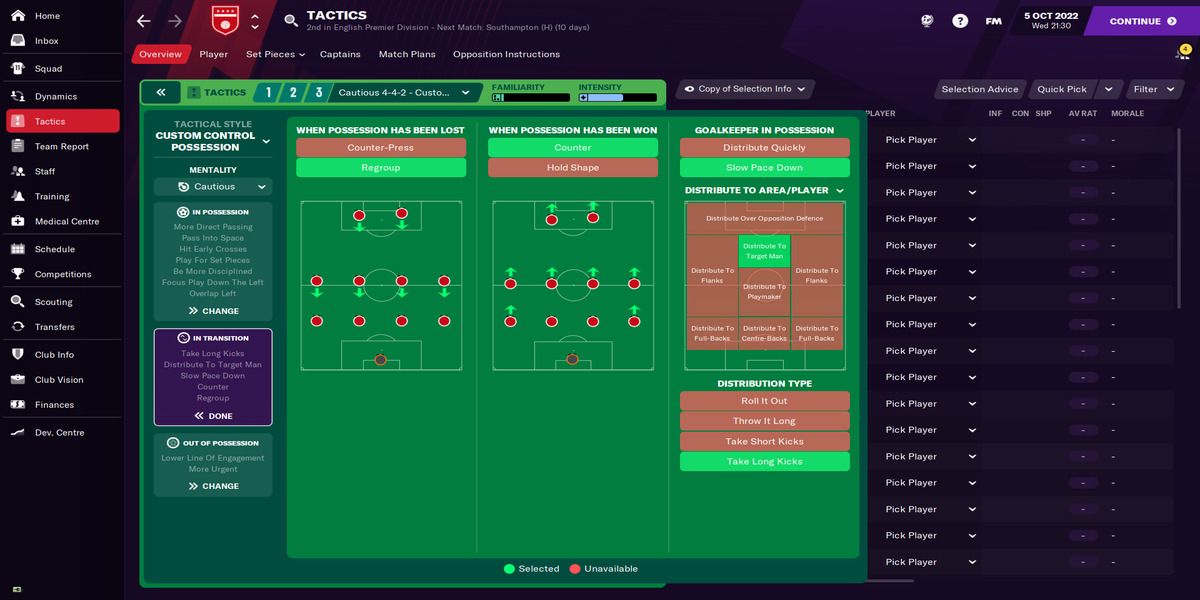
Although counter-pressing (also known as Gegenpressing) is becoming extremely popular among modern managers, it's a risky strategy that top teams can punish. To ensure that the team isn't being too defensive, however, be sure to select Counter. The one attacking benefit of regrouping is that if the ball is won back, your players can afford to spring forwards.
RELATED: The 5 Best Mario Sports Games (& The 5 Worst)
Distribute To Target Man is a great defensive option as it completely avoids the issue of opposition press around your team's goal, though it should only be selected if your team has a suitably large and imposing striker that can be a suitable target man.
Variation: If the team doesn't have a suitable target man, then there are a handful of other options available. For example, teams that have pacey strikers can opt for Distribute Over Opposition Defense and Distribute Quickly in hopes of catching the opponent's defenders out. Alternatively, it may be worth investing some money in ball-playing defenders to be able to play a more modern Distrubiute To Centre-Backs style.
7 Out Of Possession - 4-4-2
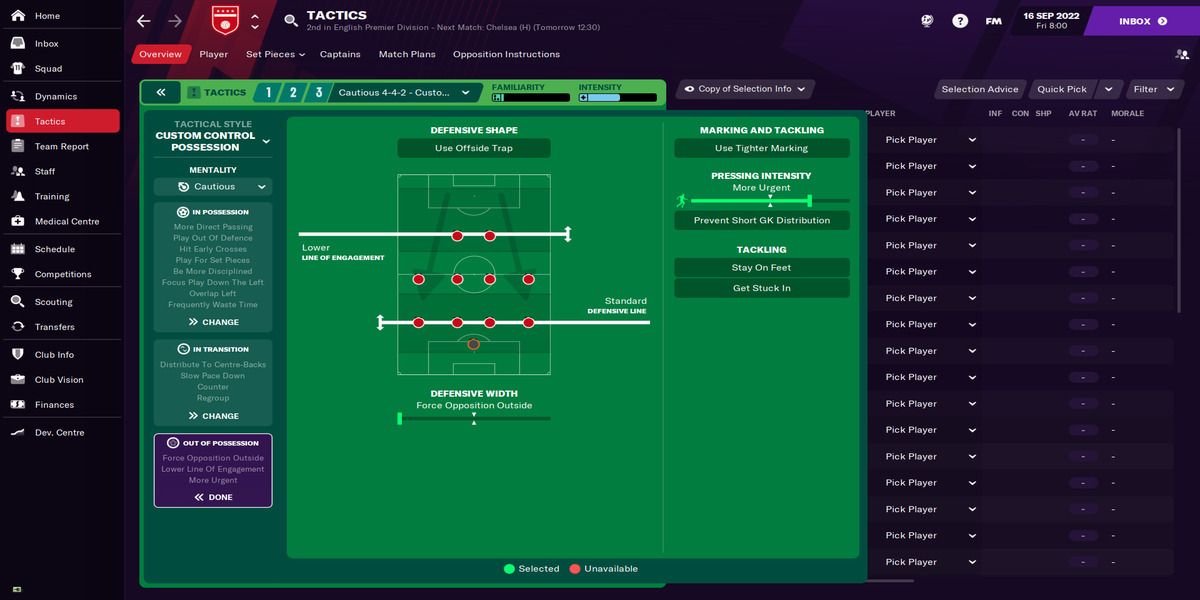
This section is key to playing a defensive 4-4-2. Structuring the team as shown above with the low line of engagement and standard defensive line will make the team play in a low block. The low block, matched with the narrow defensive width, makes this 4-4-2 formation compact and tough for opposition teams to break down, thus making it essential for the entire style of play. When playing against a far superior team, it may be worth dropping both lines down one notch.
If your team doesn't already have one, it's important to buy a goalkeeper who is good in the air and has a great command of their area when defending in this way, as the opposition will likely be swinging numerous crosses into the box.
Variation: Although it only contains a few settings, the Out Of Possession section is extremely important to the defensive structure of a team. Alternative approaches include moving both the Line Of Engagement and Defensive Line down even further, playing a so-called "park the bus" style, while potentially even dropping the Pressing Intensity down too. Be careful though, as this will invite a ton of pressure from the opposition.
6 Shape #2 - 4-4-1-1
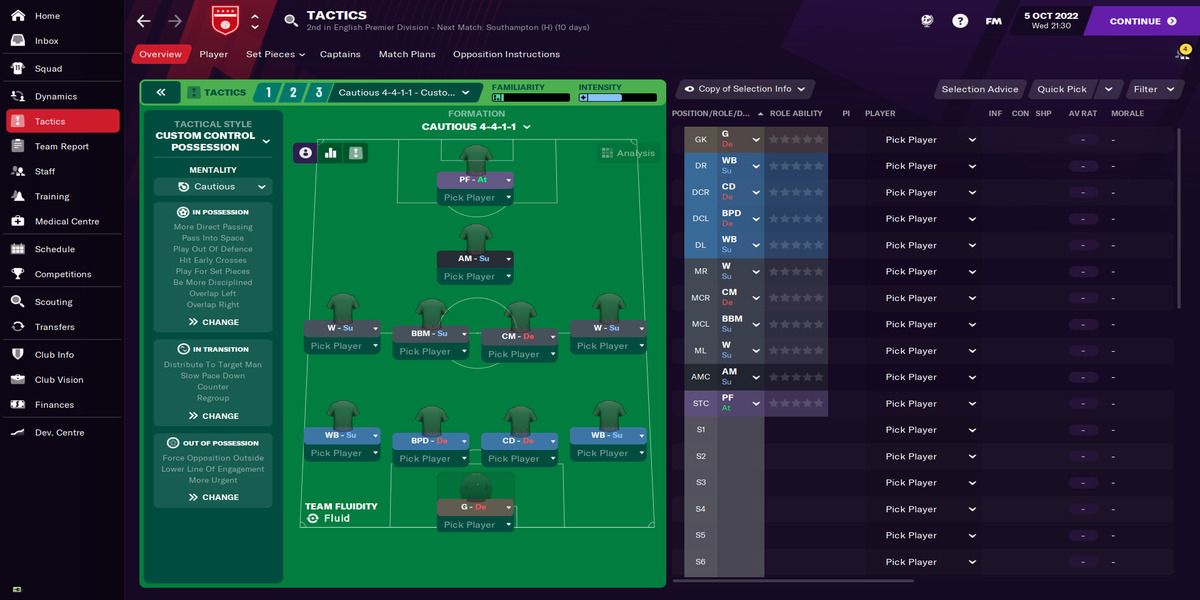
Here is a quick visual of a 4-4-1-1 that uses similar principles to the tactics mentioned previously, but is even more defensive with the slight alteration up top, making it a good choice when facing tough opposition. The 4-4-1-1 shape allows the team to attack on both sides, as the extra man in midfield offers more defensive security. It's also possible to swap the central attacking midfielder for a central defensive midfielder, allowing the wide players to push even further up the field.
Variation: Another great aspect of the 4-4-1-1 shape is that it's very versatile. Against stronger teams, the wide players can be switched to wide midfielder and full-back roles. While against weaker teams, the two wingers can be pushed up to a higher spot next to the attacking midfielder, and possibly even changed to the very offensive Inside Forward role if the team needs a goal.
5 Shape #3 - 5-3-2
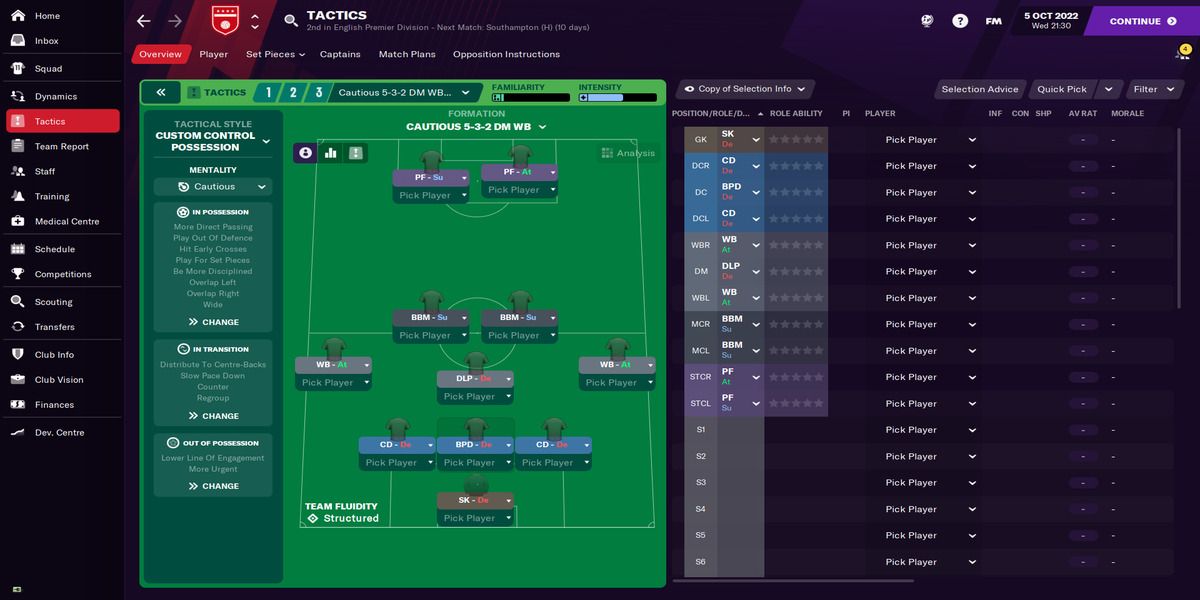
The 5-3-2 isn't just a great formation for teams slugging it out at the bottom of the table, it's also a solid option for teams battling for the title, exemplified in real-life by Antonio Conte's Inter Milan. The formation offers fantastic central coverage with the three center backs and three central midfielders, as well as the two strikers if managers want them to join in on the defensive duties.
RELATED: 10 Great Unlicensed Sports Games
It's worth pointing out that the defensive midfielder, who is pictured above as playing in the Deep Lying Playmaker role, is fundamental to making this team tick. The player will be the heartbeat of the team, by dictating the tempo of play and spraying long balls to the center-forwards and wing backs. Essentially, managers will need to find the closest player to prime Andrea Pirlo in their price range.
Variation: One aspect of this formation that will likely jump out to people wanting to play a defensive style is the wing-backs with attacking duties selected. This role is necessary to give the team an attacking presence on the flanks, though feel free to switch to a support role when worried about the strength of the opposition's wide players.
4 In Possession - 5-3-2
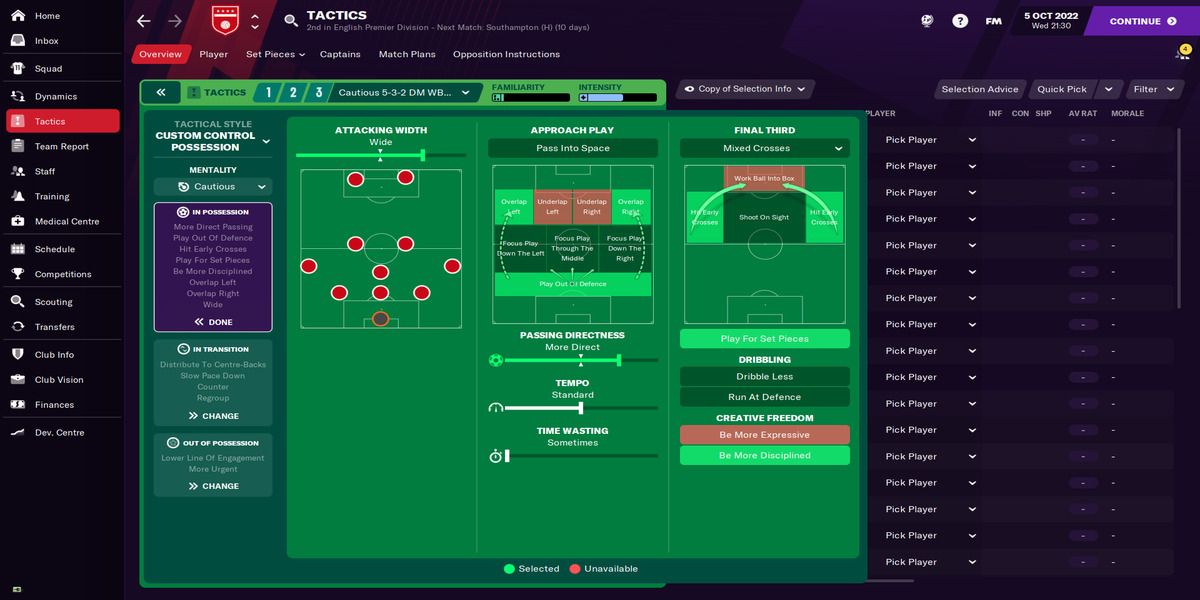
Much like with the 4-4-2 formation, this section is very dependent on the specific players in the team. Hit Early Crosses is again a good option to use due to the wing-backs bombing forward, but the extra men in midfield make it viable to switch to either Work Ball Into The Box, Shoot On Sight, or simply leave it unselected. Again, Be More Disciplined is a good choice for defensive-minded teams.
Variation: Although having three centre backs and a defensive midfielder makes the Play Out Of Defense option a possibility for even lower-table teams, it can still be dangerous if the side doesn't have strong passers at the back. Therefore, be sure to unselect it when concerned about the players' passing skills or the opposition's pressing abilities.
3 In Transition - 5-3-2
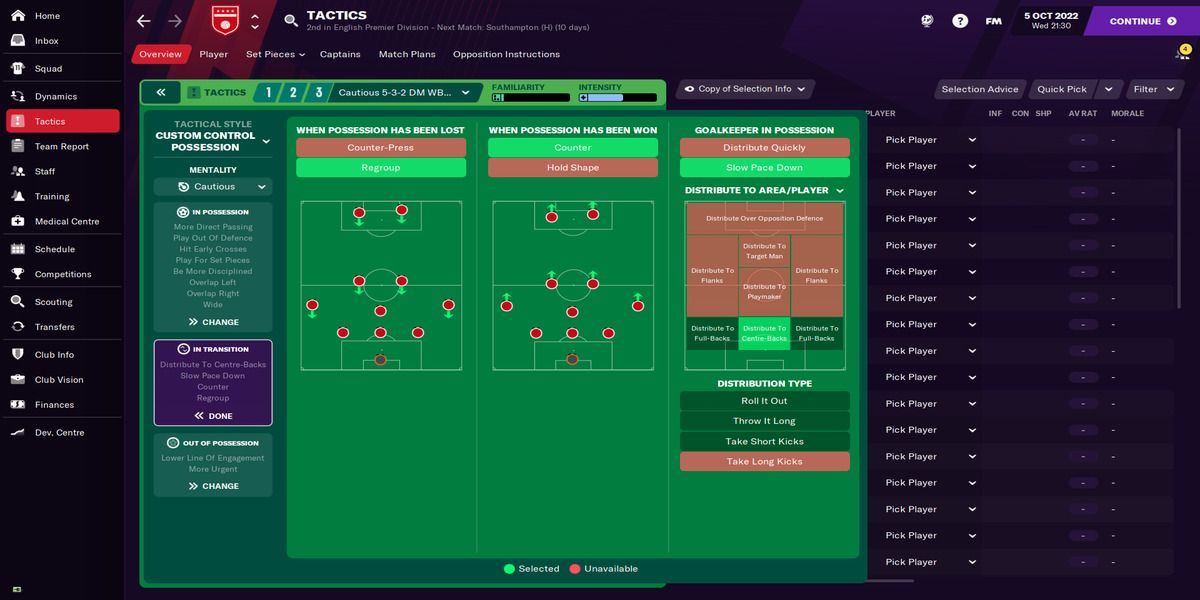
Although the extra men in midfield make it safer to counter-press than the 4-4-2 shape, it's still best to instruct players to regroup when trying to playing with a solid, defensive style. The extra center-back makes it more viable to play out from defense than with the 4-4-2, but feel free to swap it to "Distribute To Target Man" if it better suits your players.
Variation: Like with the 4-4-2 formation, teams with pacey strikers may want to opt for Distribute Over Opposition Defense and Distribute Quickly, as having two strikers and a keeper with great distribution can cause havoc for sides that are poorly organized at the back.
2 Out Of Possession - 5-3-2
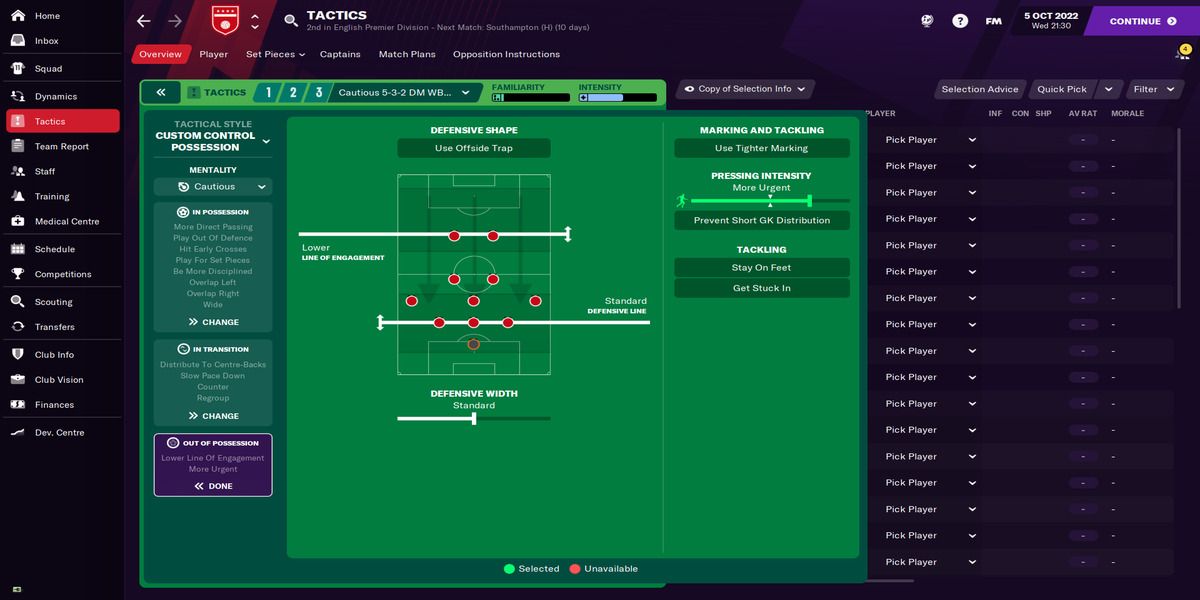
Similarly to the 4-4-2, it's best to play a low block when employing a defensive style. One key difference to the 4-4-2 shape, however, is the team's defensive width. The lack of wide players in the 5-3-2 makes playing too narrow a no-go, as the opposition will be able to overload the wide areas with ease. Pressing Intensity can be turned down in both this formation and in the 4-4-2, but it's a potentially risky move as the low block already allows the opposition plenty of time on the ball, so dropping the pressing intensity could result in the opposition being able to completely dominate the game.
Variation: One negative of having three defenders at the back and a defensive midfielder is that it can leave teams exposed in the middle of the pitch. Therefore, it may be worth changing the Line of Engagement to Much Lower, so that the strikers come to help with the midfield battle.
1 Shape #4 - 5-4-1 Diamond
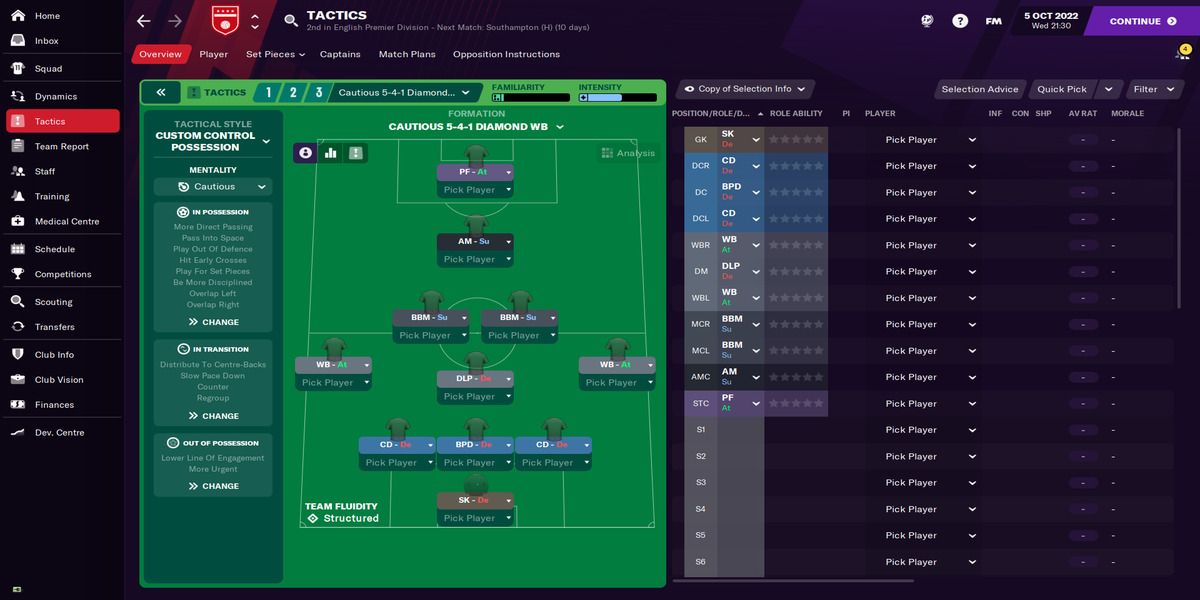
The final shape is just a quick alteration of the 5-3-2. Much like the 4-4-1-1, it's worth lower-table teams considering this alternative shape as the extra man in midfield offers better defensive cover. This shape also allows managers to be more flexible with their two players in central midfield, so don't be afraid to change the players from their safe Box to Box roles to a more Attacking Playmaker role.
These four shapes and two tactical approaches are solid, reliable options that can be used against most teams, but feel free to experiment with changes and alterations that will better suit your players. After all, that is what makes the game so enjoyable to play.
Variation: Another benefit of having an extra man in midfield is that the defensive midfielder can be more flexible. The player can either have their defensive role changed to support or alternatively, can be pushed forward to sit alongside the two box to box midfielders.
NEXT: Football Manager 21: The 10 Best Wonderkids In The Game (& How Much They're Worth)

